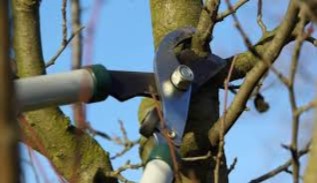
With the cooling weather many of us are excited to get some landscaping work done. Winter is a great time to add fresh mulch, to do a thorough check of your irrigation system, and to start planning for all that you want to plant come spring. It’s also a great time to prune many (not all) plants, but to do it properly here are a few tips.
Hardwood Trees
Hardwood trees and woody, evergreen shrubs can be pruned just about any time of the year as long as they are not under severe stress such as drought. To prune large trees, it’s best to hire a licensed and insured professional that has the necessary safety equipment. To find a licensed arborist in your area, visit Treesaregood.org. For trees you can safely reach, first remove any dead or diseased branches.
Winter is a great time to clearly see parasitic mistletoe that has been hiding in among the branches. Since mistletoe sends out parasitic roots into the branches, be sure to cut at least six inches down from where the plant is anchored to remove the roots. In trees where the mistletoe cannot be safely reached, a licensed pest control operator can be hired to spot spray an herbicide while the tree is dormant, usually December – early February. Mistletoe is very toxic to children and pets so be sure to pick up and dispose of any that falls out of the trees, or securely tie it up out of reach with ribbon for a lovely Christmas tradition. Once any dead or diseased branches are removed, prune out any minor branches that are crisscrossed, rubbing against another, our out of place being sure to avoid cutting flush to the trunk so the swollen collar is left to heal.
Woody Shrubs
For woody shrubs, minimal pruning is typically recommended. Sudden severe pruning to shrubs and bushes should be avoided. If a shrub is blocking views or access, gradually prune it down to the desired height. Selecting the right plant for the right place so that its mature size does not become a problem in the future is the first principle of Florida-Friendly Landscaping and your UF/IFAS Marion County Extension FFL agent or Master Gardener volunteers will be happy to assist.
Deciduous Trees
For deciduous trees that lose their leaves, such as crape myrtles, it’s best to prune while the tree is dormant and has lost all of its leaves (usually in January or early February). Avoid pruning too early before the tree has gone into complete dormancy since doing so can stunt the tree and cause severe damage to any new growth during a hard freeze. Also avoid pruning too late in the spring when the tree is trying to flush out. And lastly, do not commit crape murder! This is the nickname given to a common practice of topping crape myrtles which is usually unnecessary and quite damaging to the tree.
Tender Plants
For any plants that are more tender and more cold sensitive, it is best to hold off any pruning until after the chance of hard freeze which is typically the end of March. Some plants such as our lovely azaleas and camellias bloom in the winter months and can be pruned after they’re done blooming, but not past July 4th to avoid accidentally pruning out next year’s buds. Keeping these plants unpruned through the winter also provides habitat for some beneficial insects in various life stages that find shelter from the cold among the curled leaves and leaf litter.
For more information about pruning, contact your UF/IFAS Marion County Extension Service at 352-671-8400.
 0
0
